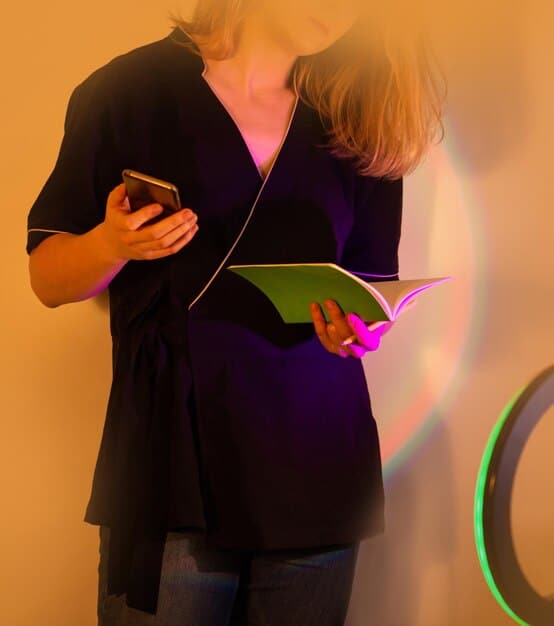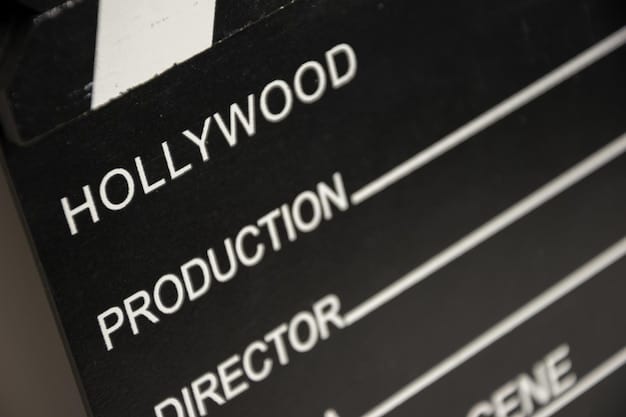Navigating K-Pop Copyright: A 2025 Guide for US Fan Creators

Navigating K-Pop Copyright Laws in 2025 requires US-based fan content creators to understand fair use, licensing options, and potential legal pitfalls when incorporating K-Pop music, videos, or imagery into their creations, ensuring compliance and avoiding copyright infringement.
Creating fan content around K-Pop is a fantastic way to express your love for the music and artists, but it’s crucial to understand the legal landscape, especially when it comes to copyright. This guide will walk US-based fan content creators through **navigating K-Pop Copyright Laws: A Guide for US-Based Fan Content Creators in 2025**, ensuring you can create and share your passion without running afoul of the law.
Understanding US Copyright Law Basics
Before diving into the specifics of K-Pop, it’s essential to grasp the fundamentals of US copyright law. Copyright protects original works of authorship, including musical compositions, sound recordings, and audiovisual works. This protection grants exclusive rights to the copyright holder, such as the right to reproduce, distribute, and create derivative works.
What is Copyright Protection?
Copyright protection automatically applies as soon as an original work is fixed in a tangible medium, such as writing, recording, or digital format. Registration with the US Copyright Office provides additional benefits, including the ability to sue for infringement.
Key Rights of Copyright Holders
Copyright holders have several key rights, including the right to control how their work is used, distributed, and adapted. This control extends to preventing unauthorized use, which is crucial for understanding how to properly use K-Pop content.
- Right to Reproduce: The owner has the right to make copies of the work.
- Right to Distribute: The owner controls the distribution of copies to the public.
- Right to Create Derivative Works: The owner has the right to create new works based on the original.
- Right to Publicly Perform: The owner controls public performances of the work.
Understanding these basic rights forms the foundation for navigating the complex world of K-Pop copyright. By knowing what rights are protected, creators can make informed decisions about how to use K-Pop content responsibly.

Fair Use and K-Pop Fan Content
Fair use is a doctrine that allows limited use of copyrighted material without permission from the copyright holder. This exception is vital for fan content creators, but it’s not a free pass. Several factors determine whether a particular use qualifies as fair use.
The Four Factors of Fair Use
US courts consider four factors when determining whether a use is fair: the purpose and character of the use, the nature of the copyrighted work, the amount and substantiality of the portion used, and the effect of the use upon the potential market for or value of the copyrighted work.
Applying Fair Use to K-Pop Content
When creating K-Pop fan content, consider how your use aligns with these factors. For example, using a short clip of a music video for commentary or criticism might be considered fair use, while using a full song to create a background track for a dance cover likely would not be.
- Purpose and Character: Is your use transformative, adding new expression or meaning?
- Nature of the Work: Is the original work factual or creative?
- Amount Used: How much of the original work are you using?
- Market Effect: Does your use harm the market for the original work?
Fair use is a complex and fact-specific analysis, and there’s no guarantee that a particular use will be considered fair. However you should analyze your usage and consult an attorney if needed.
Licensing Options for K-Pop Music
If your intended use of K-Pop content doesn’t fall under fair use, obtaining a license is the next step. A license grants you permission to use the copyrighted material in a specific way, under certain conditions. There are several types of licenses relevant to K-Pop fan content.
Types of Licenses
Common licenses include mechanical licenses for audio recordings, synchronization licenses for combining music with visual content, and performance licenses for public performances of musical works. The type of license you need depends on how you plan to use the K-Pop content.
Where to Obtain Licenses
Licenses can be obtained from various sources, including the copyright holders themselves, music publishers, and performing rights organizations (PROs) like ASCAP, BMI, and SESAC. The process for obtaining a license can vary depending on the rights holder and the type of license required.
- Mechanical Licenses: Harry Fox Agency (HFA) is a common source.
- Synchronization Licenses: Contact the music publisher directly.
- Performance Licenses: Obtain from PROs like ASCAP, BMI, or SESAC for public performances.
Securing the necessary licenses ensures that you are compliant with copyright law and avoids the risk of infringement claims.

Addressing Common Copyright Pitfalls
Even with a solid understanding of copyright law and licensing options, there can be many pitfalls when creating K-Pop fan content. Certain types of activities are more likely to raise copyright concerns than others.
Unauthorized Use of Music
Using K-Pop songs in dance covers, reaction videos, or background music without proper licensing is a common issue. Even if you’re not monetizing your content, copyright infringement can still occur.
Improper Use of Visual Content
Using music video clips, album art, or promotional images without permission can also result in copyright claims. Always seek permission or use only content that is clearly licensed for public use.
- Avoid using full songs or music videos without permission.
- Credit the original artists and rights holders whenever possible.
- Clearly state that you do not own the copyrighted material.
Being aware of these common pitfalls and taking steps to avoid them can help you protect yourself from legal issues.
The DMCA and Takedown Notices
The Digital Millennium Copyright Act (DMCA) provides a framework for copyright holders to address online infringement. A key aspect of the DMCA is the takedown notice, which allows copyright holders to request the removal of infringing content from online platforms.
Understanding DMCA Takedown Notices
If you receive a DMCA takedown notice, it means that a copyright holder believes your content infringes their copyright. You typically have the option to remove the content or file a counter-notice if you believe the takedown was in error.
Responding to Takedown Notices
If you receive a takedown notice, it’s important to respond promptly and appropriately. Consult with a legal professional if you’re unsure about your rights or obligations.
- Review the takedown notice carefully to understand the specific allegations.
- Remove the infringing content if you don’t have a valid defense.
- File a counter-notice if you believe the takedown was in error, but be prepared to defend your position in court.
Understanding the DMCA and takedown notices is crucial for protecting yourself and your content.
Best Practices for US-Based Fan Content Creators in 2025
To navigate the K-Pop copyright landscape successfully, follow these best practices for US-based fan content creators.
Obtain Necessary Licenses
Always ensure that you have the appropriate licenses for any copyrighted material you use. Don’t assume that your use is automatically covered by fair use.
Credit Original Artists
Properly attribute the original artists and rights holders in your content. This shows respect for their work and can help avoid misunderstandings.
Stay Informed on Copyright Law Changes
Copyright law is constantly evolving, so it’s important to stay up-to-date on the latest developments. Consult with an attorney or legal resource if you have questions or concerns.
- Research and understand the specific licensing requirements for K-Pop music and visual content.
- Use royalty-free or Creative Commons licensed music and images when possible.
- Consult with a legal professional if you’re unsure about your rights or obligations.
By following these best practices, US-based fan content creators can continue to create and share their passion for K-Pop while respecting copyright law.
| Key Point | Brief Description |
|---|---|
| 🔑 US Copyright Basics | Understanding rights: reproduction, distribution, derivatives. |
| ⚖️ Fair Use | Limited use without permission; consider purpose, nature, amount, market effect. |
| 🎵 Licensing | Obtain mechanical, sync, performance licenses for K-Pop music use. |
| ⚠️ DMCA Notices | Respond promptly to takedown notices; understand your rights. |
FAQ on K-Pop Copyright for US Fan Creators
▼
Using copyrighted K-Pop music without permission, such as incorporating songs in videos, covers, or remixes without obtaining the necessary licenses, generally constitutes copyright infringement.
▼
To legally use K-Pop music, you’ll need to obtain the appropriate licenses (mechanical, synchronization, and/or performance) from the copyright holders, publishers, or performing rights organizations.
▼
No, giving credit is not a substitute for obtaining the necessary licenses. While attribution is appreciated, it doesn’t grant you the legal right to use copyrighted material without permission.
▼
Copyright infringement can lead to legal action, including lawsuits, fines, and the removal of your content from online platforms. It’s crucial to respect copyright laws to avoid these penalties.
▼
Websites like YouTube Audio Library, SoundCloud, and various stock music platforms offer royalty-free and Creative Commons music that you can use in your videos without needing additional licenses.
Conclusion
Navigating K-Pop copyright laws for US-based fan content creators in 2025 requires a careful balance of understanding copyright basics, exploring fair use, and securing appropriate licenses. By staying informed and proactive, you can celebrate your passion for K-Pop responsibly and legally, ensuring your creativity thrives within the boundaries of the law.





